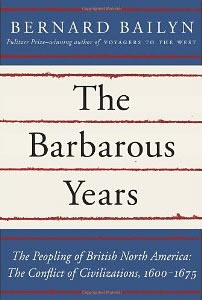Book Notes
 Bernard Bailyn, The Barbarous Years; The Peopling of British North America: The Conflict of Civilizations, 1600–1675 (New York: Knopf, 2012), 614pp.
Bernard Bailyn, The Barbarous Years; The Peopling of British North America: The Conflict of Civilizations, 1600–1675 (New York: Knopf, 2012), 614pp.
Across the last fifty years, Bernard Bailyn has distinguished himself as one of the premier historians of early America. His twenty books have earned him two Pulitzer Prizes, a Bancroft Prize, a National Book Award, and, in 2011, the National Humanities Medal. This volume completes his trilogy on the "peopling" of the North American continent that began with The Peopling of British North America (1986), an introductory volume, and then Voyagers to the West (1986), which was limited to the years 1773–1776 and based upon the survival of a complete register of the ten thousand immigrants who left the British Isles for America.
Bailyn disabuses us of the stereotype of white Anglicans displacing native Americans. There was nothing simple about this migration, nor anything genteel. Population recruitment was a continual challenge. Peoples's motives were many. It was a chaotic and violent experience for everyone, a crude and primitive existence no matter who you were. Barbarism flourished within and among all groups for widely divergent reasons, since virtually every aspect of their lives was fragile and unstable. With disease, harsh weather, and starvation constant threats, mere physical survival was an enormous challenge. By 1616, for example, only 351 of about 2,000 immigrants who had populated Virginia had survived.
Some of the immigrants were aristocrats from the wealthy intelligentsia, but only a small percentage. Many more were soldiers of fortune, convicted felons, prisoners of war, indentured servants who were bought and sold, slaves from Africa and the Caribbean (in large numbers only after 1655), orphans, and child vagrants — in other words, marginalized and stigmatized people who were looking for a better life or who had little control over their destinies. Later, truly free migrants came, like mid-level planters, often with interests that conflicted with those of English patrons back home or Puritan neighbors with their religious vision.
They comprised an ethno-linguistic polyglot group. At least eighteen languages have been identified among the Dutch settlers of New York. In addition to disaffected Puritans of various persuasions, there were the Catholics who settled Maryland, German Lutherans, Scottish Presbyterians, a few Jews, and that most seditious of all the many "enthusiast" sects, Quakers. Their dreams and schemes targeted the Atlantic seaboard from Florida to Nova Scotia (although Bailyn focuses on New England, New York, and the Chesapeake Bay).
These people faced deep conflicts in every area of life — savage racial conflicts with the Indians, bitter religious conflicts within and between groups, conflicts with public and private authority (economic, social, legal, civil, political), conflicts about property rights, and conflicts among ethno-linguistic subcultures. But by the end of the seventeenth century, after all the strenuous decades to normalize their abnormal lives, the Atlantic seaboard was a globalized world, what one scholar calls the first "hemispheric 'community'" in human history. And all of that a hundred years before the founding of the United States.


